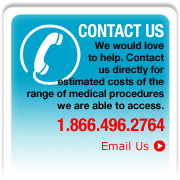
|
|
Heart By-Pass SurgeryEvery year, thousands of clients that are uninsured, under-insured or self-insured turn to North American Surgery Inc. to have their surgeries performed close to home at or below the cost of overseas procedures. Why travel great distances and take unnecessary risks for uninsured medical procedures such as coronary bypass surgery when affordable alternatives exist in the US? If you need coronary bypass surgery, but you are uninsured, North American Surgery can help you. What is coronary bypass surgery?The most commonly performed major surgery in North America, coronary bypass surgery takes a piece of vein from the leg or chest and uses it to replace part of a heart artery that has been blocked or narrowed. The surgeon may need to perform a single, double, triple, quadruple or quintuple bypass. This simply refers to the number of coronary arteries bypassed (partly replaced) during the surgery. Note that having a greater number of bypasses does not imply a person is sicker, nor does a lesser number mean the person is healthier. Why do I need coronary bypass surgery?If your doctor has diagnosed you with coronary artery disease, and your disease has not be controlled by medication or lifestyle changes, and an angioplasty is not possible (or it succeeded but the artery has narrowed again), you may be a good candidate for coronary bypass surgery. Coronary artery disease occurs when the blood vessels that supply your heart becomes narrowed or blocked by fatty deposits known as plaque. This plaque narrows the arteries – and sometimes even blocks them – making it difficult for the blood to get through. And without a continual supply of fresh, oxygen-rich blood, your heart cannot do its job. What will happen during coronary bypass surgery?Coronary bypass surgery usually takes between three and six hours and requires a general anesthetic. Once you’ve been anesthetized, a breathing tube will be inserted through your mouth and into your lungs. The tube is attached to a ventilator which breathes for you during and immediately after the surgery. During traditional coronary artery bypass surgery, known as CABG (pronounced “cabbage”), the surgeon will make a large incision to open your chest and examine your heart. He or she will then “harvest” the graft veins from your leg or chest and temporarily “stop” your heart. You will be attached to a heart-lung machine, also known as a bypass pump, that will operate while the surgeon is attaching the graft or grafts. One end of each graft is sewn onto the coronary artery before and after the blockage. Following this, your heart will be “restarted.” In recent years, doctors have developed new, less invasive procedures. Off-pump coronary artery bypass surgery (OPCAB) allows the surgeon to work without using the heart-lung machine. More recently still, minimally invasive direct coronary artery bypass surgery (MIDCAB) allows the surgeon to work through a very narrow incision – usually in the range of five to 10 centimetres. These alternatives are not suitable for every case; you should discuss your options with your surgeon. What are the possible complications of coronary bypass surgery?Coronary bypass surgery has been performed for more than 30 years and is a very successful technique for dealing with cardiac disease. As with any surgery, however, it carries some risks. Patients who are over 70, who are female, who have had previous heart surgery and who have another serious medical condition, such as diabetes, emphysema or kidney disease are all at higher risk. During the surgery, a heart attack or stroke may occur. There is also the risk of blood clots, heavy bleeding, and the risks associated with the anesthetic itself. Some patients will get an infected wound or suffer from post-pericardiotomy syndrome which causes fever and chest pain. (This can be treated with medication). Some people report memory loss or a lack of mental clarity after the surgery; this usually resolves itself within six to 12 months. What happens after coronary bypass surgery?After your surgery, you’ll be taken to the intensive care unit for several hours to several days and carefully monitored. Your total hospital stay will likely be in the five to seven day range and your total recovery period will be somewhere between four and 12 weeks – depending on your overall health and the nature of your surgery. Your surgeon will likely recommend a cardiac rehabilitation program. It will also be important for you to make lifestyle changes such as stopping smoking, improving your diet and increasing exercise. After surgery most people remain symptom-free for several years but it’s likely that the coronary artery disease will eventually return, meaning that you may require further treatment. What to do if you are Uninsured, Under-Insured or Self-InsuredNorth American Surgery Inc. acts as a facilitator, bringing our clients together with private medical clinics and hospitals that can provide the needed services and/or procedures in a timely manner and at affordable prices to the uninsured. If you are uninsured and want more information about private medical care, contact North American Surgery Inc. today. |




|
SITEMAP | Copyright 2025 North American Surgery |
About UsFor the last four years we have been facilitating surgical procedures for clients wishing to access the favorable pricing which we have negotiated with hospitals and clinics across the country. |
ServicesNorth American Surgery Inc. is able to access reasonably priced surgical procedures of all types in U.S. based facilities. Our clients pay a small fraction of the standard prices charged by most U.S. hospitals. Typically the prices we have negotiated are comparable to the costs associated with off-shore surgery in places such as India, Thailand or Mexico. |
ProcedureThe role of our firm is to act as a facilitator, brining our clients together with private medical services and clinics which can provide the needed services and / or procedures in a timely manner. Once arrangements have been made to the mutual satisfaction of our client and their physician, we have no ongoing involvement in the doctor-patient relationship. |
NEWSFAQsTestimonialsLinks |